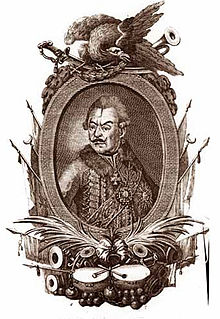Peter Tekeli | |
|---|---|
 1787 engraving, exhibited in the Pushkin All-Russian Museum (Всероссийский музей А.С. Пушкина), Saint Petersburg. | |
| Viceroy of Caucasus | |
| In office 1787–1789 | |
| Preceded by | Pavel Potemkin |
| Succeeded by | Ivan Saltykov |
| Personal details | |
| Born | 1720 Arad, Military Frontier, Habsburg monarchy |
| Died | 1792 (aged 71–72) Novomirgorod, Russian Empire |
| Relations | Sava Tekelija, his nephew |
| Awards | Order of St. George Order of St. Anna Order of St. Alexander Nevsky Cross of Saint Vladimir |
| Military service | |
| Allegiance | |
| Branch/service | Cavalry |
| Years of service | 1741–1748 (Pomorišje Militia in the army of Habsburg Monarchy) 1748–1790 (Imperial Russian Army) |
| Rank | General-in-Chief |
| Commands | Arad Company of Pomorišje Militia Serbian Hussar Regiment Armed forces in Novorossiya |
| Battles/wars | |
Peter Tekeli (Russian: Пётр Авраамович Текели, romanized: Pyotr Avraamovich Tekeli;[1] Serbian: Петар Поповић Текелија, romanized: Petar Popović Tekelija;[2] Hungarian: Tököly-Popovics Péter; 1720–1792) was a Russian general-in-chief of Serb origin. He achieved the highest rank among the Serbs who served in the Imperial Russian Army.
Tekeli was born in a noble family of military tradition, whose men were officers of the Austrian army in the Military Frontier. Prior to his emigration to Russia in 1748, he fought as a young officer in the War of the Austrian Succession. Characterized by both courage and military cunning, he made a splendid career in Russia. He participated in the Seven Years' War, the Russo-Turkish War of 1768–1774 and the Russo-Turkish War of 1787–1792. Under his command, the Zaporozhian Cossacks were disbanded and subjugated to the Imperial authority in 1775, without spilling a single drop of blood, for which he received the Order of Saint Alexander Nevsky from Empress Catherine the Great. He retired in 1790, and died two years later in his mansion at Novomirgorod.
- ^ Текели is also spelled Текелий, and Тюкюли. Peter Tekeli’s Russian patronymic Авраамович (Avraamovich), spelled also Абрамович (Abramovich), results from the fact that his father’s name Ranko does not exist among Russians, and they replaced it with Avraam or Abram.
- ^ Popović is often omitted.